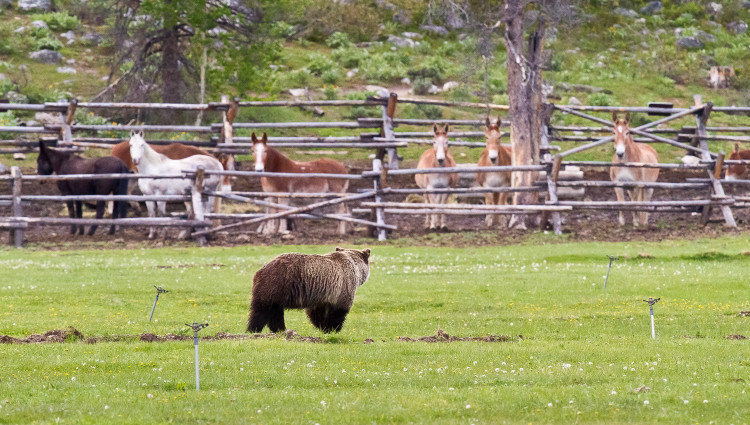
Wyofile by Angus M. Thuermer Jr.– Conflicts with hunters and livestock were among the reasons a record 59 grizzly bears died in the Yellowstone ecosystem in 2015, the federal government’s grizzly coordinator said last week.
In addition to running into hunters and being removed for killing stock, grizzlies also faced a dry year and were seen more often in developed areas, said Chris Servheen, grizzly bear recovery coordinator for the U.S. Fish and Wildlife Service. He leads the effort to establish an enduring population in the Yellowstone region.
The number of deaths “was the highest number of grizzly mortalities in the Yellowstone Ecosystem since 1970,” Servheen said in an email. He put the number in perspective, writing that the losses are “not a big deal in terms of population-level impacts.
“Remember,” he wrote, “that there are three times as many bears in the ecosystem today as in 1970.” An estimated 717 grizzlies live in the ecosystem today, according to the Interagency Grizzly Bear Study Team, but some question the accuracy of that figure.
Grizzly deaths are recorded according to sex and age. The number of females older than two years is an important component of the population. Consequently, managers have set an annual limit for adult female mortalities at 7.6 percent of the population.
In 2015 adult female grizzly deaths exceeded that figure by 0.1 percent, Servheen wrote. Adult males died at 11.7 percent, well below their 15 percent limit.
“Bottom line is that annual mortalities fluctuate in natural systems and individual years will vary,” Servheen wrote.
Numbers are key part of Endangered Species Act delisting
The health and size of the population are critical factors as the federal government begins to remove Endangered Species Act protection from the Yellowstone-area population. Wyoming, Idaho and Montana could subsequently institute a grizzly hunting season.
Fifty-five of the deaths in 2015 were human-caused. Investigators are probing the death of 19 Yellowstone-area grizzly bears, according to the mortality table. “Investigation” is a label applied to probes of grizzlies believed killed by hunters, poachers or nefarious actors.
Fourteen bears were killed or otherwise removed from the population for conflicts with livestock and 12 for getting human food or for property damage, the 2015 mortality table shows. Five bears were euthanized through management actions, four died as a result of collisions with vehicles, two were natural deaths and three bears died of unknown causes.
The 2015 mortality figure of “known and probable” deaths exceeds the previous annual high of 55 that was set in 2012, grizzly bear advocate and watchdog Louisa Willcox wrote WyoFile in an email. There also are unrecorded bear deaths, she said, and they could bring the 2015 tally up to 90 bears.
Although the federal population estimate was set at 717, it covers a range that could be as low as 642, Willcox said. That led to her worst-case estimate.
“Bottom line: there could be as few as 552 bears in the ecosystem,” she wrote. If 90 bears out of 642 were killed, that amounts to 12 percent of the official population number and would bring the ecosystem count to “below the basement level of 600.”
Six hundred is the fewest bears that the U.S. Fish and Wildlife Service would allow — after delisting — before it would prohibit “discretionary mortality.” U.S. Fish and Wildlife director Dan Ashe referenced that limit in a letter he sent to state game directors in September.
An agency spokeswoman said the 600-bear minimum likely would never be reached after Endangered Species Act protections are removed. “The goal would be to manage for approximately 674 grizzly bears to ensure a sustainable and resilient population that utilizes the entire available habitat in the Greater Yellowstone Ecosystem,” Serena Baker wrote in an email. “We do not anticipate population numbers to dip down to 600 bears.”
Members of the Interagency Grizzly Bear Study Team also say the population survey could under-estimate bears by 40 percent. That wide range perplexes some, including Wyoming Wildlife Advocates. That nonprofit advocacy group asked Ashe in November for a “definitive GYE grizzly bear survey.”
Federal estimates spread over a range of plus or minus 472 bears, wrote Kent Nelson, director of the group. “At this point IGBST’s ‘best available science’ starts looking more like a wild-ass guess,” Nelson wrote Ashe.
“There is a far better alternative to the chaotic situation,” he wrote. That would constitute “a survey of the GYE grizzly population using DNA hair analysis.”
The current estimates are based on mathematical modeling, following observations, including those made from aerial surveys.
